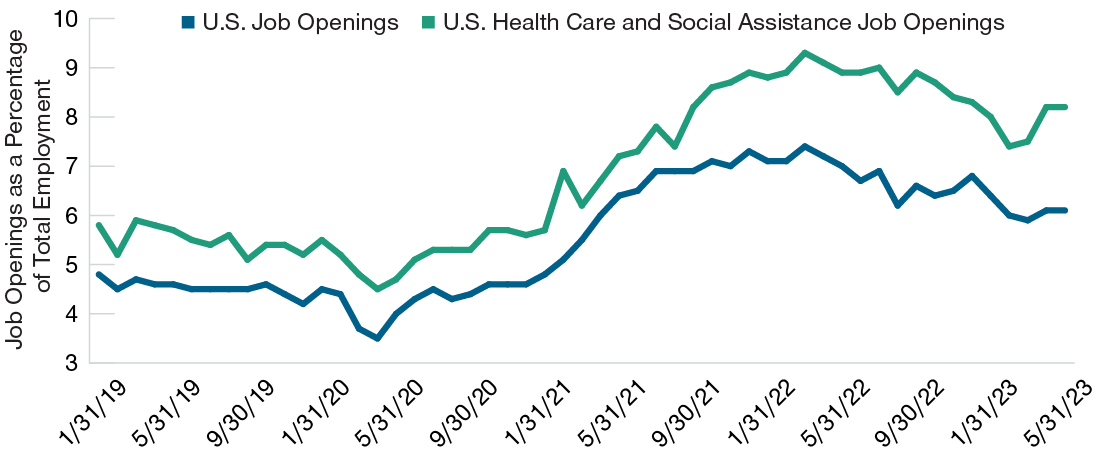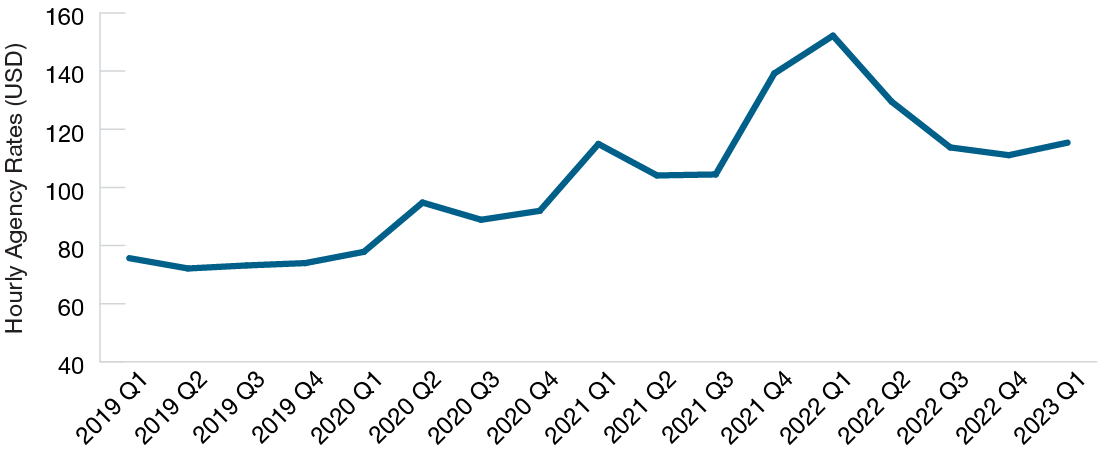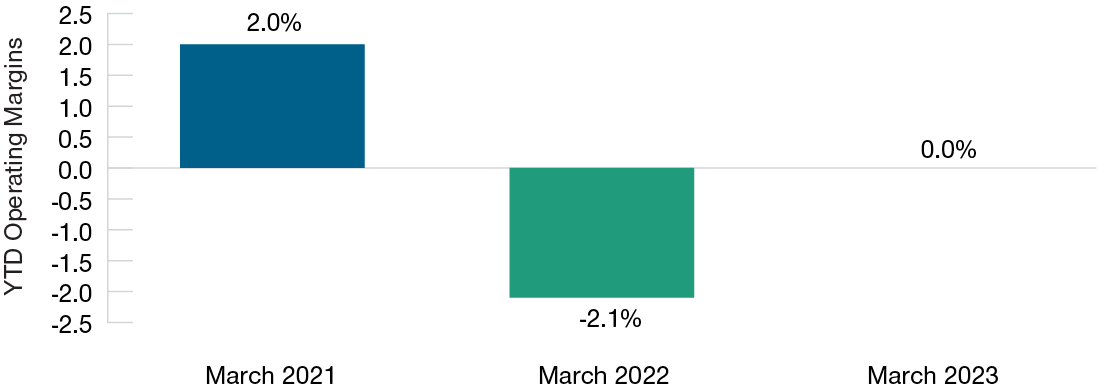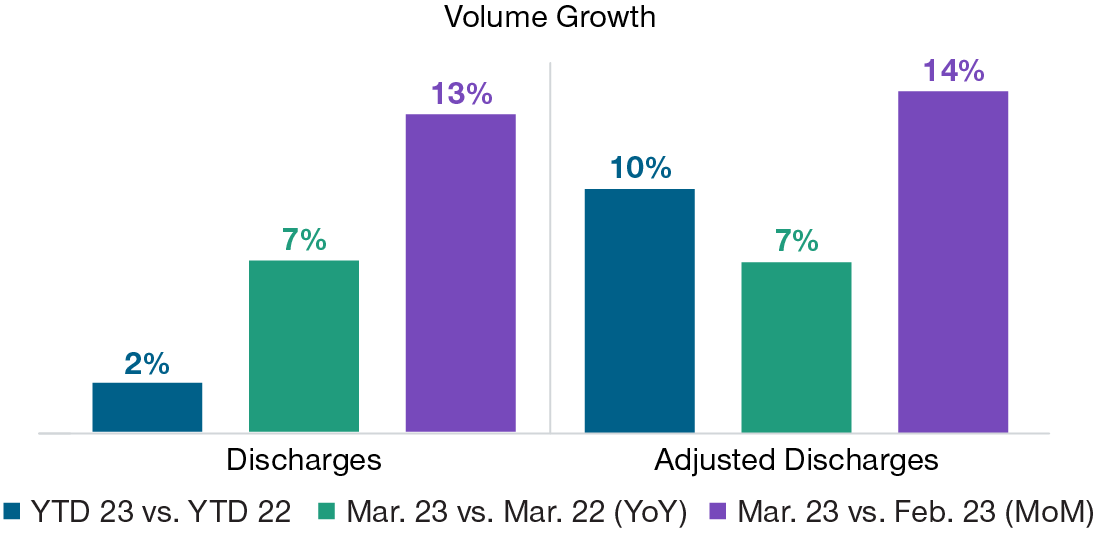fixed income | july 10, 2023
Post-Pandemic Trends Support Credit Quality in Health Care
Collaboration across health care industries reveals credit trends.
Key Insights
While the pandemic introduced unprecedented volatility into the health care space, we are cautiously optimistic that pressures driven by COVID have peaked.
We expect the fundamental credit quality of health care providers and medical technology companies to gradually improve.
Health insurers increased rates after the onset of the pandemic prior to renegotiating reimbursement rates, so we think their credit profiles will be stable.

Domingo Villarruel, CFA
Municipal Credit Analyst

Mitch Unger
Investment-Grade Credit Analyst

Marianna Korpusova, CFA
High Yield Credit Analyst
While COVID introduced unprecedented volatility into the health care space, we are cautiously optimistic that pressures driven by COVID have peaked, and we expect the fundamental credit quality of most health care providers and medical technology companies to gradually improve. Conversely, health insurers benefited from the ability to increase rates after the onset of the pandemic prior to renegotiating reimbursement rates with providers, so we anticipate that the credit profiles of health insurers will remain stable.
Subscribe to T. Rowe Price Insights
Receive monthly retirement guidance, financial planning tips, and market updates straight to your inbox.
Pandemic Headwinds for Hospitals
COVID presented many headwinds for hospitals; some of those, such as the temporary suspension of elective procedures, were short-lived. Others, such as elevated labor costs, continue to linger to varying degrees. Various federal and state COVID relief funding initiatives offset much of the lost revenue from the suspension of elective procedures, but most of those funds have now been exhausted.
Nurse burnout, early retirements, and higher-paying agencies that specialize in providing health care labor support turbocharged a nursing shortage that existed prior to the pandemic, pushing hospital labor costs even higher. Figure 1 illustrates how U.S. health care and social assistance job vacancies increased even more than vacancies in the broad job market during the pandemic.1
Health care systems responded by boosting pay to attract and retain talent, increasing overtime pay to fill staffing gaps, and relying on expensive agency labor. Figure 2 shows the material escalation of hourly agency rates relative to pre-pandemic levels. Although rates vary by regional market, broadly speaking, the hourly agency rate was roughly USD 75 before the pandemic, peaked at approximately USD 150 during the omicron surge, and moderated to around USD 110 in the first quarter of 2023.2
Health Care Vacancies Surged in Pandemic
(Fig. 1) Job openings as a percentage of total employment

As of May 31, 2023.
Source: Department of Labor.
Hourly Agency Labor Rates Still High
(Fig. 2) But agency costs are well below post-pandemic peak

As of March 31, 2023.
Sources: AMN Healthcare Services, Inc., T. Rowe Price estimates.
Suspension of Elective Procedures Weighed on Medical Technology Firms
In addition to challenging health care providers, the suspension of elective procedures and the intensified nursing shortage negatively impacted medical technology companies. Staffing shortages prevented providers from operating at full capacity, let alone recapturing the procedures that had been deferred during the acute phase of the pandemic. Procedure volumes—and therefore demand for medical products—remained stubbornly below pre-pandemic levels through 2021 and most of 2022, creating a headwind for medical technology companies.
Multiyear Contracts Helped Insulate Insurers From Cost Pressures
While health care providers experienced margin compression from material wage inflation, health insurers were structurally insulated from this pressure.
Reimbursement rates paid by insurers to providers are locked in under multiyear contracts with low fixed annual escalators or negotiated increases in payments to providers, but health insurers reprice their insurance books annually. This gives insurers the ability to raise premiums before provider contracts are renegotiated (i.e., the ability to price ahead of unit cost inflation). This dynamic allowed health insurers to grow earnings at or above their long-term growth averages in 2022 even as health care providers struggled to maintain their profitability.
But Contracts Dragged Down Provider Profitability
The multiyear contracts that helped provide stability to insurers resulted in many hospital systems experiencing a meaningful decline in profitability over the last 18 months or so, leading to a deterioration in credit metrics such as debt service coverage3 and debt-to-EBITDA.4 As shown in Figure 3, health care systems have recently started to show signs of margin improvement due in part to lower contract rates and agency utilization.
Nevertheless, higher full-time employee (FTE) costs and above-average use of contract labor compared with pre‑pandemic levels continue to weigh on provider operations. Over time, health care systems should be able to pass these costs through to insurers as contracts come up for renewal and are renegotiated. It is important to note that health insurers have already started to pass these costs through to their customers by raising premiums. As a result, we expect the fundamental credit quality of insurers to remain stable.
 Nevertheless, higher full‑time employee (FTE) costs and above average use of contract labor compared with pre‑pandemic levels continue to weigh on provider operations.
Nevertheless, higher full‑time employee (FTE) costs and above average use of contract labor compared with pre‑pandemic levels continue to weigh on provider operations. 
Operating Margins Have Improved
(Fig. 3) Easing labor costs support first-quarter margins

As of March 31, 2023.
Past performance is not a reliable indicator of future performance.
Source: Kaufman Hall National Hospital Flash Reports.
New Staffing Strategies Help Labor Retention
Agency labor costs moderated as management teams across health care providers implemented a variety of strategies to shift contract labor into full‑time staff. Through our conversations with dozens of health care leadership teams, it appears that new staffing strategies such as pay increases, sign-on bonuses, and enhanced fringe benefits have improved retention rates and lowered agency demand. It is still not clear what the net savings will ultimately be from lower agency use, as higher permanent costs in the form of higher FTE wages may offset lower agency spend.
However, margins seem to be moving in the right direction. Figure 3 lays out the first-quarter operating margins for the U.S. health care sector for years 2021–2023, which shows a gradual improvement as expenses, particularly labor, have eased; first-quarter 2021 operating margins were 2%, first-quarter 2022 were -2.1%, and first-quarter 2023 were about flat based on preliminary data.5
Procedure volumes have increased, boosting the topline for hospitals even as moderating staffing costs support the bottom line. The data shown in Figure 4 illustrate recent discharge and adjusted discharge6 volume growth that includes increases of 2% and 10%, respectively, for 2023 through March versus the same period in 2022 as well as favorable growth of 13% and 14%, respectively, in March from February. The backlog of patient procedures that built up over the last few years should continue to support this trend. We also expect this backlog to drive strong demand for medical products in the near to intermediate term, a credit positive for medical technology companies.
Medical Procedure Volumes Have Increased
(Fig. 4) Procedures have continued to rebound post-COVID

As of March 31, 2023.
Source: Kaufman Hall National Hospital Flash Reports.
Adjusted discharges standardize all patient revenue in terms of discharges.
YTD=Year-to-Date. YoY=Year-over-Year. MoM=Month-over-Month.
Health Care Industries Adapt to Pandemic Unwinding in Varying Ways
With many of the abrupt changes to the sector that resulted from the coronavirus pandemic unwinding, different health care industries stand to benefit in varying ways. Labor cost pressure and procedure capacity constraints are abating, which is already supporting health care provider margins and helping medical technology companies increase their revenues. Cost pressures during the height of the pandemic did not have the same degree of negative effects on health insurance companies because of their long-term contracts with providers, and insurers have already started passing costs along through higher premiums in an effort to maintain their financial stability.
What We're Watching Next
As with many other segments of the economy, artificial intelligence could eventually have profound effects on the health care sector. The advanced technology has the potential to impact labor costs across the sector, and it could change the way that medical technologies companies in particular develop new products.
1Department of Labor’s Job Openings and Labor Turnover Survey, Bloomberg Finance L.P.
2AMN Healthcare Services, Inc., publicly available disclosure. Actual rates are not disclosed, so we estimated approximate amounts based on publicly available information.
3Debt service coverage is revenue available for debt service (operating revenue minus operating expenses plus other nonoperating net revenue such as cash investment income) divided by debt service (principal and interest payments).
4Debt-to-EBITDA is balance sheet debt divided by operating income (excluding depreciation and interest from operating expenses).
5Kaufman Hall National Hospital Flash Reports (April 2023).
6Adjusted discharges standardize all patient revenue in terms of discharges.
Important Information
This material is provided for informational purposes only and is not intended to be investment advice or a recommendation to take any particular investment action.
The views contained herein are those of the authors as of June 30, 2023 and are subject to change without notice; these views may differ from those of other T. Rowe Price associates.
This information is not intended to reflect a current or past recommendation concerning investments, investment strategies, or account types, advice of any kind, or a solicitation of an offer to buy or sell any securities or investment services. The opinions and commentary provided do not take into account the investment objectives or financial situation of any particular investor or class of investor. Please consider your own circumstances before making an investment decision.
Information contained herein is based upon sources we consider to be reliable; we do not, however, guarantee its accuracy. Actual outcomes may differ materially from any estimates or forward-looking statements provided.
Past performance is not a reliable indicator of future performance. All investments are subject to market risk, including the possible loss of principal. Health care firms may be dependent on government funding and regulation and are vulnerable to product liability lawsuits and competition from low-cost generic products. Fixed-income securities are subject to credit risk, liquidity risk, call risk, and interest-rate risk. As interest rates rise, bond prices generally fall. All charts and tables are shown for illustrative purposes only.
202307-2975809
Next Steps
Gain valuable perspective on the markets and what’s ahead.
Contact a Financial Consultant at 1-800-401-1819.